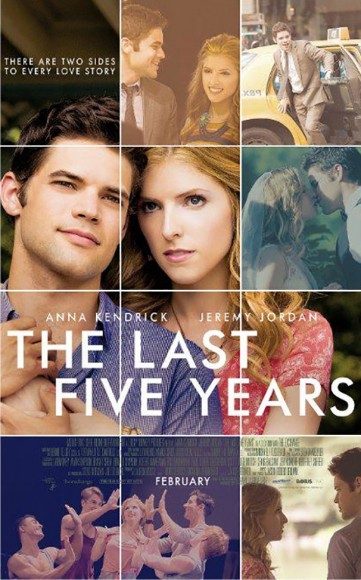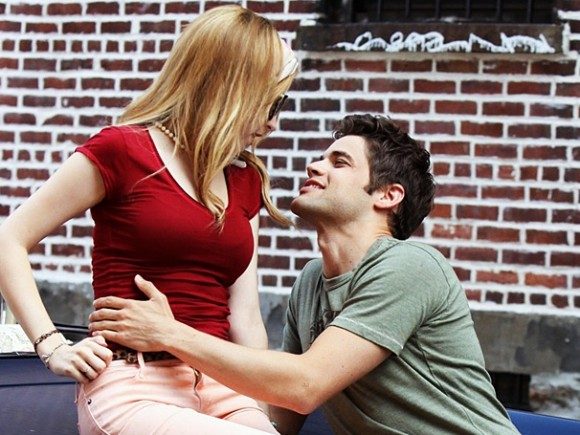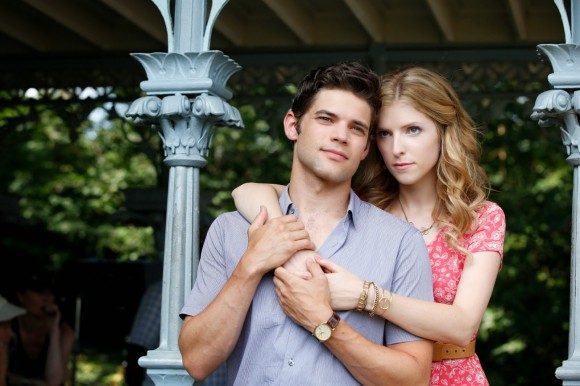Wow we’re having a rash of timeline-twirling troubled romances, aren’t we? Near the end of last year saw both The Disappearance of Eleanor Rigby and Comet; now comes The Last Five Years, an adaptation of Jason Robert Brown’s stage musical about the five year span of a relationship between a man and a woman in their 20s that’s told from beginning to end half the time and end to beginning the other half.
More specifically, the half that roughly follows the perspective of Cathy (Ana Kendrick, Into the Woods) opens the pic right after her breakup with Jamie (Jeremy Jordan, TV’s now-defunct Smash) and moves back to near the beginning of their relationship. A scene after her sorrowful ballad announcing the ultimate failure of their romance, we’re transported back five years the half that follows Jamie’s perspective and moves forward chronologically to that final point.
I’m immensely curious to hear the opinion of someone who walked into this movie not knowing that structural conceit (so if that’s you, sound off in the comments). It’s not as though the movie’s trying to hide its narrative trick, it’s right there in the trailers for anyone who wants to see; still, if you happened to wander into The Last Five Years not knowing what was going to happen, I bet you’d be lost for at least the first half of the movie. Even so, this is one of the reasons I was anticipating the The Last Five Years. I like structural creativity, and often an old narrative displayed in an exciting new way gains fresh life. The juxtaposition of a hollowed Cathy in the first scene with a joyful and energetic Jamie and Cathy together in the second is effective – how did we get from here to what we just saw? And yet, the jumping back and forth can be a bit tricky at times, even if you are paying attention. This is one of those rare instances where I would have appreciated some subtle on-screen titles announcing which year of the relationship each scene belonged to.
I can say “each scene” because this is a Musical with a capital “M.” As in there are no scenes outside of song, and the entire movie is made up of songs that mostly take place during a single event – for the most part solos for either Cathy or Jamie, they rarely sing together – with barely a line of dialogue in the whole running time. The music is all pop-orchestral, stuff that would be right at home on (or maybe just off) Broadway. The songs are fun, with some quippy lyrics along the way, but nothing really memorable. Kendrick and Jordan are both very good vocally, and although both emote well while singing (or listening to the other sing), neither is called upon for any particular subtlety. The presence of a camera requires talent that they both possess, but this is a stage play at heart, so the emotions are always big ones.
It might be the stage play roots, and what seems to be an unwillingness on the part of writer/director Richard LaGravanese (P.S. I Love You) to move away from them too significantly, which prove to be The Last Five Years’s biggest hurdles. LaGravenese definitely heard the Tom Hooper Les Miserables complaints loud and clear, so while he and Steven Meizler enjoy their long shots, they do keep the camera mving. The trouble is, the movement is rarely with a purpose. A shot at the opening titles, for instance, pushes closer to a building while booming up from the first floor exterior to the third floor before dropping down once again to the first floor window and showing us nothing of consequence along the way. Or a camera will travel around from one side of a stationary actor’s face to the other, suggesting some turn of perspective with the scene and the song, only to return back to a former angle. Which might suggest realignment with the original point of view, except that The Last Five Years never has quite that much depth, and the camera is only moving to not stay still.
The other place the movie veers too close (I’m assuming) to the stage play is in the way the characters of Cathy and Jamie are expressed over the course of the narrative. There never seems to be quite enough room within each scene or song for either one to arc meaningfully. The nature of the story’s structure means that we’re seeing very particular high and low points in Cathy and Jamie’s relationship rather than a broader perspective on its progression, so we’re supposed to fill in for ourselves the parts that go in between each song. And we can to an extent, but the movie always left me hoping for more. We know how this story ends – badly – and so the interesting part is in watching the cracks form. But since it’s difficult to trace their path over time when we’re only given a few points of reference, it’s a bit like trying to spear a fish while blindfolded and having someone else call out instructions to you. Both characters end up feeling underdeveloped, while we in the audience are drug through the heartache of a failed relationship but left with surface level excuses for what went wrong. This would seem to be the ultimate failing in the way the story is conceived. Witness to both sides of the romance, we in the audience should be able do divine what each character could not and emerge with some clearer, if still imperfect, idea of what caused their fracture.
The Verdict: 2 out of 5
The easiest, and maybe the best, way to describe The Last Five Years to someone is to say it’s a music video for a concept album. Yes, each song conjures up a scene in your head. And yeah, we basically get to watch those scenes. But a collection of 14 pretty good music videos is not the same thing as a complete movie. There are some meaningful flaws with technical aspects of the filmmaking, but far beyond that, it’s hard to argue that there’s enough meat on these bones of narrative and character to fully constitute a “Feature Film.” Maybe I’m asking the movie to be something it’s not, but at 94 minutes long, there was time to show a few scenes in between the songs, and I wish we’d gotten a more complete and meaningful picture of its characters and their failed relationship.




